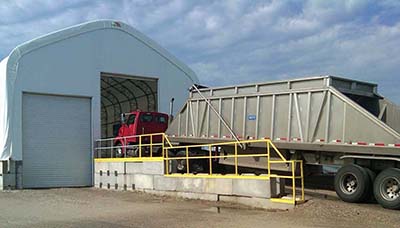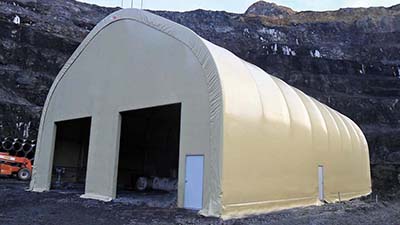By Brett Bodzinski
Whether they are used for drilling, excavation, loading or hauling, there is no question that in the aggregates industry, vehicles are heavily relied on to complete essential tasks day in and day out. When vehicles are used as frequently as they are for aggregate sales and storage, they need to be regularly maintained and repaired or they run the risk of becoming inoperable, quite possibly bringing a whole operation to a standstill.

But for many companies that work at multiple jobsites in a year, constructing a traditional permanent garage structure for maintenance and storage is not financially feasible. That is why many operations over the years have come to see that there is no better solution to satisfy these needs than a fabric structure.
Fabric structures have been rapidly rising in popularity and are becoming the standard structural solution in many industries. This is largely due to the fact that they have little foundation requirements and can be built at a low cost per square foot, allowing operations to obtain a building that that can be constructed on-site without the large investment in time and money that often accompanies traditional buildings. Fabric structures have proven to be especially effective as garages used to maintain, repair and house various vehicles used for aggregate sales and storage.
Important vehicles becoming inoperable can certainly put projected timelines and potential profits at risk. Maintaining these vehicles can be extremely difficult, but without a garage it can be near impossible. Fabric structures feature high clearances to accommodate large vehicles commonly used in the industry and can be built in various sizes, from a small maintenance garage, to a large repair facility, all at a low cost per square foot.
Organizing a crew inside of a fabric structure can even boost productivity by keeping them organized and separated from outside conditions. Just as important as maintaining vehicles, is properly storing vehicles while not in use. Storing vehicles inside of a fabric building prevents unnecessary expenses by reducing damage in the form of corrosion, rust and rot can begin to occur. Proper storage and maintenance are the easiest way to stop any preventable wear, extending the length of time between costly and time-consuming repairs.
Versatile
Fabric structures are extremely versatile, some manufactures of these structures can even customize them further to meet a customer’s exact specifications. Manufacturers can extend clearances, provide equipment specific for vehicle maintenance and can even specifically engineer them to withstand local snow and wind loads, allowing for greater durability and smoother operating efficiency. Fabric structures can also be built much faster than a traditional building of similar size. The whole process of building a 15,000- to 20,000-sq.-ft. facility can take as little as two months, with installation taking some companies just a few days, allowing operations access to a building when they need it the most.

When it comes to foundation options, fabric structures offer a wide array of options and they can be built just about anywhere an operation could need, even atop an existing foundation. Some more common traditional foundation options include concrete blocks and pads, wooden posts or blocks, pony walls and more that can be specially selected for the function the building is needed for.
Some companies that manufacture fabric structures even offer more innovative options, such as helical anchors or shipping containers that can perfectly compliment an operation. One of the greatest benefits of using a fabric structure is that although they can offer strength of permanent foundation, they can be easily relocated without compromising their structural durability.
This allows operations to have a mobile garage structure that they can reuse from job to job, while also minimizing the environmental impact on a site, lessening the amount of time and resources needed to remediate a site after the job is complete.
Choosing
When an operation is looking to invest in a fabric structure it is a good idea to make sure they choose a structure that provides the best cover, frame and design to satisfy their needs. A garage for heavy-duty vehicles needs to large enough to adequately accommodate these vehicles, while also being versatile and mobile. Some manufacturers even offer warranties on covers and frames, extending the longevity and usable life of the structure.
When it comes to choosing a cover, operations should be looking for a structure that is clad with a polyethylene fabric cover. A polyethylene fabric cover offers incredible protection for crews and vehicles inside from inclement weather, dust and debris, providing foremen and project managers peace of mind.
These covers allow light to filter through, creating a well-lit environment that is soft-on the eyes, while also increasing visibility and creating a comfortable environment that crews can effectively work in. During the day, these covers allow enough light to permeate through that there is no need for supplemental lighting, so companies can reduce energy bills and increase profits, while further decreasing their environmental footprint.
When operations are looking for a suitable frame, they should opt for a galvanized steel frame. A galvanized steel frame provides structures with incredible durability and strength and is incredibly resistant to corrosion, allowing it to serve operations for a much longer time compared to traditional structures that use other materials.
Galvanized steel frames also allow buildings to be built on a much bigger scale, so operations can construct garages that are able to accommodate many more vehicles. Certain frames and layouts even promote natural ventilation; fumes, unwanted odors and moisture can air out, further promoting safety and comfort.

Clear Span Design
Many fabric structures feature a clear span design, meaning that the building is constructed in such a way that it features no internal support posts. The lack of support columns on the inside of the structure provides operations with the maximum amount of space for vehicles and workspace.
This layout is ideal for the aggregate storage because the large open spaces and higher clearances, accommodate large vehicles giving them an adequate amount of space to be stored and maintained. More space for vehicles and crews allows for a more fluid and safer operation, boosting overall productivity.
Compared to traditional structures, fabric structures are above and beyond the right option to provide the aggregates industry with a reliable garage to store and maintain vehicles in. With all of the immediate and long-term benefits operations gain with a fabric structure, they should almost always be in the front-running for the ideal structural solution.
Brett Bodzinski works for ClearSpan Structures. For more than 40 years, ClearSpan has been providing governments and municipalities with innovative building solutions. For more information, visit www.clearspan.com.
